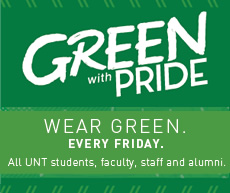Search
In the news
Read the latest stories featuring UNT people and programs.
Quick links
Common UNT web resources for faculty and staff.
A pursuit to understand nature
 When Harlan W. Butt was walking the trails of Glacier National Park in Montana, he whistled and wore bells used to deter bears.
When Harlan W. Butt was walking the trails of Glacier National Park in Montana, he whistled and wore bells used to deter bears.
That precaution also helped create his art.
“That inspired paying attention,” said Butt, a Regents Professor of studio arts. “You observe a lot more. You’re not thinking about yourself or your needs. You’re just there.”
He’s created a series of vessels inspired by his journeys to the national parks. Ten to 12 of those vessels will be on display at the exhibition Harlan W. Butt: National Parks Project Feb. 5–27 at UNT on the Square.
A reception will take place from 5:30 to 7 p.m. Feb. 5. Butt visited the parks and created the work during when he had a semester off from teaching as a Faculty Fellow from the Institute of the Advancement of the Arts, the arm of UNT that promotes artistic and creative expression.
Since 2003, Butt has traveled to about a dozen parks — including Acadia in Maine, Denali in Alaska and Yellowstone in Wyoming. He even had an artist-in-residency at the Grand Canyon in Arizona and Denali in Alaska. During those journeys, he has journaled, photographed, sketched and written haiku about his surroundings.
Once home, he created the vessels. The vessels meld his two lifelong passions – art and the outdoors. As a child, he was a Boy Scout and frequently went camping. He has been working in metalsmithing and jewelry, making boxes, reliquaries and other types of vessels throughout his career.
“Every vessel is an extension of my pursuit to understand nature,” he said. “These vessels document that pursuit.”
He forms the vessel shape out of metal, then applies the enamel through different processes – such as cloisonné or champlevé.
 For the Grand Canyon, he wanted to capture the feeling of being on the rim of the canyon, where viewers see the moonscape of the rocks. He also included a replica of the bright orange feather of an Oriole he observed near the canyon. (Right.)
For the Grand Canyon, he wanted to capture the feeling of being on the rim of the canyon, where viewers see the moonscape of the rocks. He also included a replica of the bright orange feather of an Oriole he observed near the canyon. (Right.)
For Acadia, one vessel features a bonsai-like tree that was arched over the lake and the brilliant colors of the autumn leaves. Another vessel shows seagulls flying over the seashore.
• Find pictures of his National Parks vessels.
Each vessel also contains a haiku he wrote — an art form he took up after living in Japan.
“To me, haiku requires that one be totally aware,” he said. “It’s an expression so short there’s no excess. It’s supposed to express nature and to be selfless. It is another layer of communication that I add to each piece.”
And he was never at a loss of creativity at the parks.
“Even though national parks are regulated, the environment is close to the way it existed before humans occupied it,” he said. “It is constantly inspiring.”
—Jessica DeLeòn, University Relations, Communications and Marketing
Above, Butt works in his studio. Photo by Gary Payne/URCM. Bottom, Butt at the Grand Canyon. Courtesy Harlan Butt.

Posted on: Thu 07 January 2016
- Login to post comments
Owning Excellence
Faculty and staff members have roles in transforming UNT into a nationally prominent university. Share your ideas on how you can help UNT to own excellence, keep students on track and improve graduation education.
Deadlines
No current Deadlines










